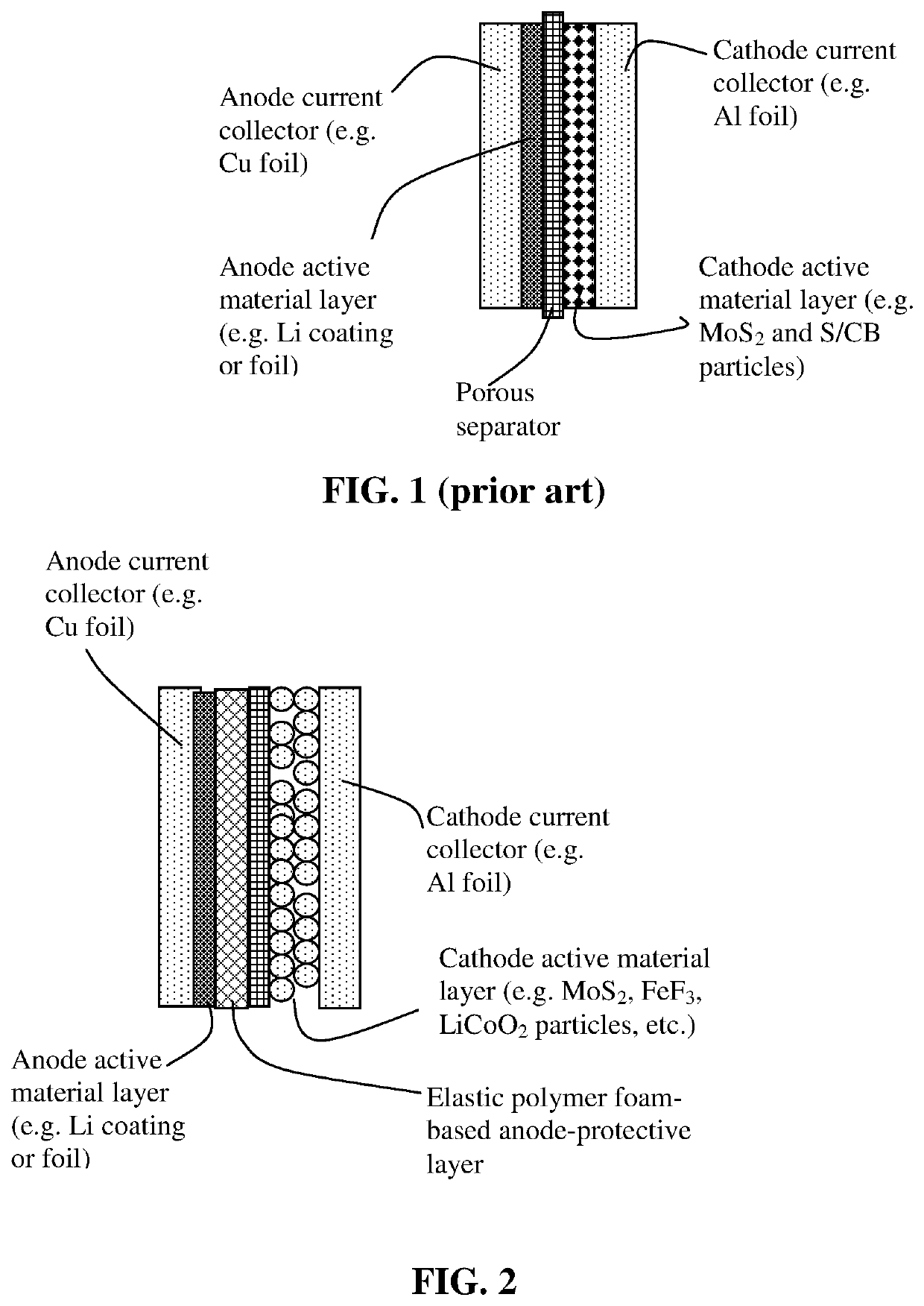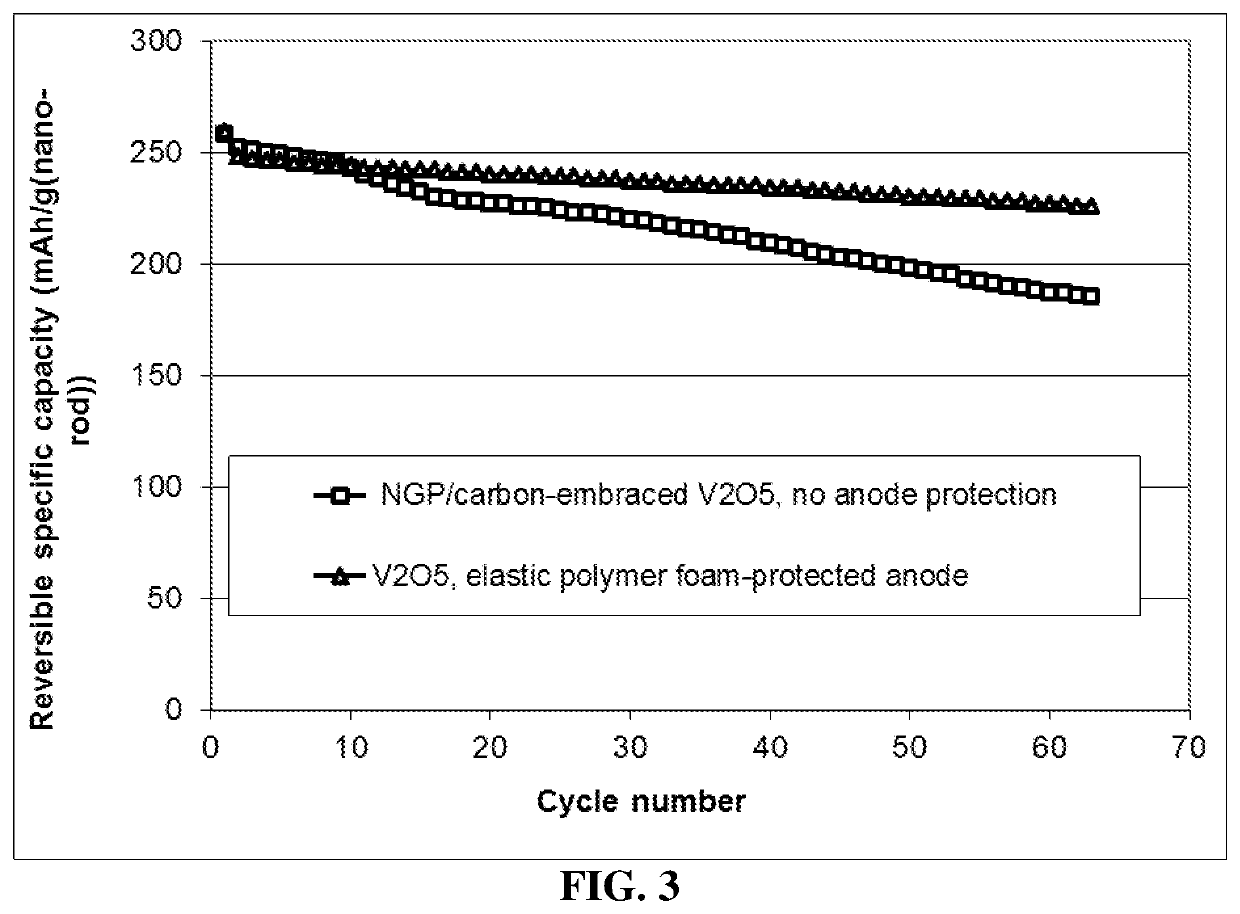Method of improving cycle life of a rechargeable lithium metal battery
a rechargeable lithium metal battery and cycle life technology, applied in the field of rechargeable lithium metal batteries, can solve the problems of internal electrical shorting, thermal runaway, unsafe conditions in the battery, etc., and achieve the effect of reducing or eliminating lithium metal dendrite and more conducive to uniform deposition of li metal during battery charges
- Summary
- Abstract
- Description
- Claims
- Application Information
AI Technical Summary
Benefits of technology
Problems solved by technology
Method used
Image
Examples
example 1
lowing Agents and Pore-Forming (Bubble-Producing) Processes
[0123]In the field of plastic processing, chemical blowing agents are mixed into the plastic pellets in the form of powder or pellets and dissolved at higher temperatures. Above a certain temperature specific for blowing agent dissolution, a gaseous reaction product (usually nitrogen or CO2) is generated, which acts as a blowing agent.
[0124]Chemical foaming agents (CFAs) can be organic or inorganic compounds that release gasses upon thermal decomposition. CFAs are typically used to obtain medium- to high-density foams, and are often used in conjunction with physical blowing agents to obtain low-density foams. CFAs can be categorized as either endothermic or exothermic, which refers to the type of decomposition they undergo. Endothermic types absorb energy and typically release carbon dioxide and moisture upon decomposition, while the exothermic types release energy and usually generate nitrogen when decomposed. The overall g...
example 2
oam of Sulfonated and Non-Sulfonated Triblock Copolymer Poly(Styrene-Isobutylene-Styrene) or SIBS
[0127]Both non-sulfonated and sulfonated elastomer foams are used to build the anode-protecting layer in the present invention. The sulfonated versions appear to be more compatible with lithium metal. The elastomer matrix can contain a lithium ion-conducting additive, an electronically non-conducting reinforcement, and / or a lithium metal-stabilizing additive.
[0128]An example of the sulfonation procedure used in this study for making a sulfonated elastomer is summarized as follows: a 10% (w / v) solution of SIBS (50 g) in methylene chloride (500 ml) was prepared. The solution was stirred and refluxed at approximately 40° C., while a specified amount of acetyl sulfate in methylene chloride was slowly added to begin the sulfonation reaction. Acetyl sulfate in methylene chloride was prepared prior to this reaction by cooling 150 ml of methylene chloride in an ice bath for approximately 10 min....
example 3
on of Sulfonated Polybutadiene (PB) Foam
[0131]A representative procedure is given as follows. PB (8.0 g) was dissolved in toluene (800 mL) under vigorous stirring for 72 h at room temperature in a 1 L round-bottom flask. Benzophenone (BZP) (0.225 g; 1.23 mmol; BZP / olefin molar ratio=1:120) and TAA (11.9 mL; 0.163 mol, TAA / olefin molar ratio=1.1) and a desired amount of Nylon fibers (0%-40% by wt.) were introduced into the reactor, and the polymer solution was irradiated for 1 h at room temperature with UV light of 365 nm and power of 100 W.
[0132]The resulting thioacetylated polybutadiene (PB-TA) / Nylon fiber composite was isolated by pouring 200 mL of the toluene solution in a plenty of methanol and the polymer recovered by filtration, washed with fresh methanol, and dried in vacuum at room temperature (Yield=3.54 g). Formic acid (117 mL; 3.06 mol; HCOOH / olefin molar ratio=25), along with a desired amount of foaming agent, sodium hydrogen carbonate) were added to the toluene solution...
PUM
| Property | Measurement | Unit |
|---|---|---|
| thickness | aaaaa | aaaaa |
| compressive strains | aaaaa | aaaaa |
| compressive strains | aaaaa | aaaaa |
Abstract
Description
Claims
Application Information
 Login to View More
Login to View More - R&D
- Intellectual Property
- Life Sciences
- Materials
- Tech Scout
- Unparalleled Data Quality
- Higher Quality Content
- 60% Fewer Hallucinations
Browse by: Latest US Patents, China's latest patents, Technical Efficacy Thesaurus, Application Domain, Technology Topic, Popular Technical Reports.
© 2025 PatSnap. All rights reserved.Legal|Privacy policy|Modern Slavery Act Transparency Statement|Sitemap|About US| Contact US: help@patsnap.com



